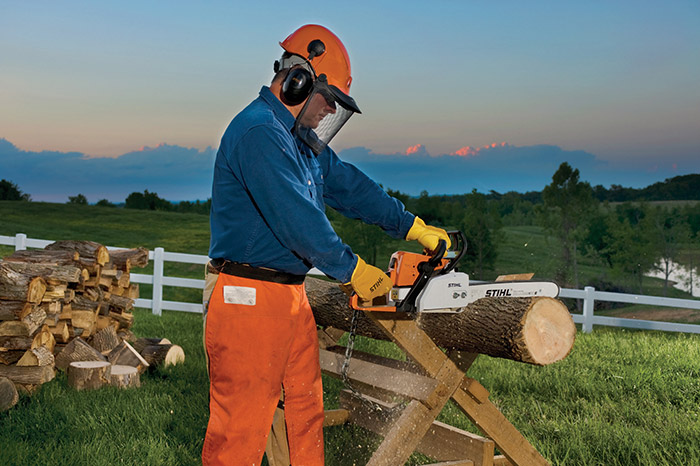New Braunfels Feed & Supply offers firewood, perfect for the cool fall and winter nights. Use it in your fireplace or outside in your firepit. Swing by the store and stock up on firewood now, before the cool weather hits. Below are some tips from Stihl on how to split, stack and store firewood. Great for the DIY’ers.
For wood-burning fireplace and stove owners, splitting and stacking wood is an important skill to know. Whether it’s your first time stacking a woodpile or you just want a refresher course on proper splitting technique, we’ve got a number of helpful tips on the best way to stock winter wood.
Are You Cutting Wood From a Fallen Tree?
If you’re starting your wood pile right from the source – a fallen tree – there are a few things to keep in mind when doing the initial cutting. First, the timing: cut your firewood at least six months ahead of when you plan on burning it. The ideal time to cut firewood is in the late winter and early spring months. This allows for the maximum drying time.
Next, cut the ends of the logs as flat and square as possible so that they can stand sturdily for splitting. For this, we recommend the STIHL Pro Splitting Axe or STIHL Pro Splitting Maul. If the wood has branches, cut toward the opposite direction they are pointing. Remember, the shorter the log, the easier it will split. Look for hairline cracks on the log and direct the swing of your axe to strike these cracks. This will reduce the splitting effort. Try to avoid cutting through knots – knots and branches change the direction of the wood grain in the log and make splitting more difficult. Try to align the strike of the axe so it does split through the knot.
Wood Burning Safety
Burning firewood creates many byproducts, including smoke, water vapor, various gases, hydrocarbons and tar. Over time, these materials can accumulate in your fireplace and increase your risk of danger, including chimney fire and carbon monoxide poisoning. Always keep your fireplace chimney well ventilated and have it cleaned. The U.S. Consumer Product Safety Commission, the U.S. Environmental Protection Agency, the National Fire Protection Association, and the American Lung Association recommend annual maintenance and inspection of your home’s heating systems, fireplaces included.
Wood Selecting
Purchasing Firewood
Buying firewood is a convenient option for those who enjoy wood fires but don’t have the time or means to cut and season their own. Buying the right wood in the right amount, however, does require some research. Wood vendors sell all year, but could charge more during the colder months due to higher demand. Plan ahead and buy in the late spring and summer months. Ask if the wood is “ready to burn” and has been properly seasoned. Fresh wood requires at least 6 months of seasoning time before it is dry enough for optimal burning.
Wood Amounts
Wood Types
Get more burn for your buck by selecting the right kind of wood for your fire. Softwoods, such as pine, fir, spruce, and redwood will burn quickly and you might find yourself filling the wood rack more often. Hardwoods such as oak, eucalyptus, beech and birch will burn longer and “cleaner,” leaving less creosote residue behind. NOTE: Trees with gnarled, knotted grains, such as hickory and elm are more difficult to split.
Wood Splitting
Prep Work
Measuring
Swing Technique
Chopping Tips
Wedges
For larger rounds, STIHL recommends using a STIHL Splitting Wedge, paired with either a STIHL Pro Splitting Maul or STIHL Woodcutter Splitting Maul. These mauls feature heavier bits and a flat side for driving in wedges. Wedges and mauls are great tools when dealing with large, dense or gnarled wood.
NOTE: As always, wear protective workwear and eyewear to help protect against flying debris.
Wood Stacking
Groundwork
Stacking Technique
Wood Pile Structures
There are several established types of firewood structures you can choose. Ultimately, your storage space will determine which structure works best for you. Regardless of what structure type you choose, ensure your stacking technique allows for proper airflow and is stable enough to allow for significant settling – wood pieces shrink as they dry.
Storing Tips
However the wood is stacked, expect the wood to dry for at least six months before it is ready for the fireplace. Freshly cut wood can have up to 100% moisture, which means around half of its weight is water. The ideal moisture content for firewood is around 20%. How do you know if the lumber is ready? Seasoned wood will turn gray, but color is not the only indicator. Look for hairline cracks along the edges. Seasoned wood will also weigh less and make a higher-pitched sound when knocked together. Unseasoned wood will make a low “thud” when banged together. If at all possible, keep the lumber pile sheltered from precipitation, while still exposed to airflow and sunlight. Tree bark is a natural moisture barrier, so arrange the lumber to maximize evaporation. If a lot of rain is expected, arrange the wood pieces bark side up. If there is a lot of ground moisture from snow or standing water, arrange wood pieces bark side down.
See these helpful links to video tips from STIHL for selecting, cutting and storing firewood: